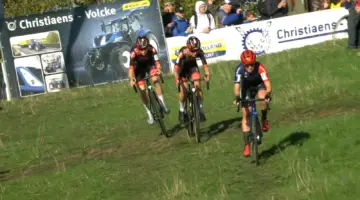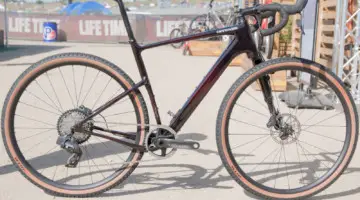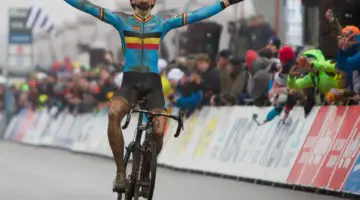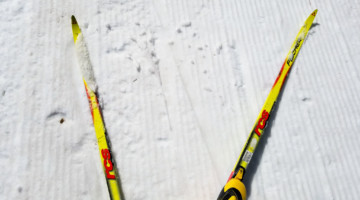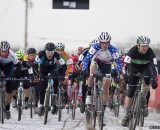
Train like a National Champion! Here at Worlds, Steve Tilford wasted no time moving to the front in the first 100 feet, and within one lap had 40 seconds. © Cyclocross Magazine
We asked each and every Nationals medalist just how he or she does it. What’s the training like? What kind of cross training do you do? What workouts do you love to hate? How do you plan nutrition? Responses were varied, so once we narrowed down to some of our favorite answers, we asked Cycle-Smart coach Jacob Fetty and JBV Coaching’s Chris Mayhew to weigh in on which workouts and approaches to training were the most effective.
On Training:
Karen Brems, 50-54 Women
I race pretty much every weekend from September–January, and that is a big part of my training. Here in NorCal, we typically race on Sundays, so Saturday is a short pre-race ride with some efforts to open up for the race. Monday and Friday are recovery days, and Tuesday–Thursday are my high intensity days. I combine my training with commuting to work on my bike. I typically do a hard group ride on the road one of those days, and the other two days are cyclocross-specific. I have a couple of different parks I go to and have little courses I do at each, that focus on specific skills—run-ups, some barriers, hills, turns etc. I basically do hot laps. My cool-down is riding to work. I am a big believer in quality over quantity in training. I almost never ride more than two hours at a time during the season. I also take a “rest week” once a month or so with four to five days of only low intensity riding.
I certainly hear things in her approach that make a lot sense: ’cross specific riding, quality workouts and rest. The best way to get faster on your ’cross bike is to practice going faster on your ’cross bike. A big limiter I see people create for themselves is not practicing at speed, especially the bike driving and transitions part. Karen seemingly does a good job of infusing this into her training.—Jacob Fetty
Emma White, 15–16 Women
Generally, I race on the weekends. I leave everything I have on Saturday and Sunday’s courses. On Monday, I take the day off. I use this day to rest, refuel, and unpack from the weekend. On Tuesdays, I do an hour spin. When it was warmer out and the daylight hours were longer, I was able to ride on the road. But, more recently, I get home from school too late to go out on the road, so I ride on the trainer. Wednesdays are more difficult. Depending on how far into the season I am, and if I’m racing the following weekend, I will do a tough training session. This consists of intervals, and lots of sweat! Thursday is another trainer session. Typically, it is an hour long. This isn’t an easy spin, but a consistent effort. On Friday, I try to do a quick spin with some short and intense sprints before a big race weekend. However, by the time we get home from school and are done packing, it is late and we are on our way to the next race venue!
If I were the Superintendent where Emma goes to school, I would let her take some time in the afternoon to train. She can get her studies done in the evening, rather than ride the trainer. It is very impressive to see such focus and dedication. And, it is impressive to see someone do so well on a tough course when so much of their training lacks driving their bike. What we see Emma apply to her training is that she is taking good rest in the form of a couple days off following a double weekend. This is intelligent and something that I recommend. Generally, over eager, hyper-motivated athletes like to get right back to it on Tuesday. The fitter the rider the sooner one can get back to intensity. However, a good rule of thumb is one day of recovery for each day of racing. —Jacob Fetty
Pete Webber, Masters 40–44
A normal week for me during ’cross season is pretty simple: race on the weekend and do a hard ride at “Wednesday worlds.” Monday, Tuesday, and Thursday are recovery, possibly some endurance miles but usually not. Friday is openers. If I don’t race both days on the weekend, I’ll do a longer ride on Sunday or during the week.
Peter Webber has been a world-class athlete for decades, literally decades. He can get by with doing a lot less than someone that has only been competing for a few years. Still, what rings true is that he is placing the impetus on the weekend racing, then fitting the intensity in as it fits his race schedule and his recovery. Like Emma, it appears that Peter is recovering two days from the weekend block. —Jacob Fetty
Steve Tilford, Masters 50–54
My training is old school by all accounts. I usually try to use racing to get fit for racing. For ’cross, that is sort of hard. Usually racing just makes you tired for racing. I’d love to find a week-long stage race in the middle to end of December to do before ’cross Nationals. That would be the perfect training.
Like Peter, Steve has been a world-class athlete basically his whole life. I feel sorry for the competitors in Steve’s category. What I try to do in my coaching approach is to construct a stage race workload or training block as best as possible for my athletes. Balance is the key. It is generally not practical to put that much training stress on yourself when you are 50+, working and have a family, so we monitor the power numbers daily in our build. But, like we all know, Steve is the exception to the rule. —Jacob Fetty
Lessons to Take Away:
With regards to structuring the week, I am struck by how uniformly people have figured out what works. Everyone has a great balance of rest and recovery, and prioritizing recovery, which is critical in ’cross both because of the intensity and the travel involved. I might quibble with which days people choose to go hard, but on the whole on both a macro and micro level, people really seemed to have things dialed in. People are doing the right workouts at the right time, such as openers before races (which might be the hardest workout to fit in!) —Chris Mayhew
Find out more National Champion secrets, from favorite workouts to nutrition to off-season antics by ordering an archive copy of Cyclocross Magazine Issue 20, available in print or digital format!























